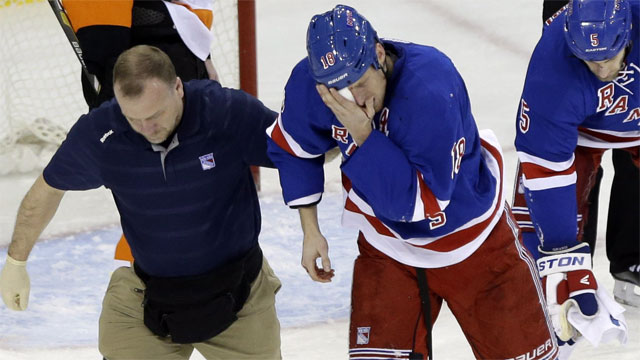TORONTO — Progress? Possibly.
One day we might look back on this relatively subdued meeting of NHL general managers as the moment when attitudes finally changed about the need to protect the eyes of the world’s top hockey players.
There certainly seems to have been a shift in thinking.
In revealing plans for the NHL Players’ Association to poll its membership about grandfathering in visors for next year, union executive Mathieu Schneider sounded a different tune than we’ve been accustomed to hearing from that group.
“With the injuries we’ve seen, part of me thinks the time has come,” Schneider told Sportsnet.ca.
For years, the union has vehemently defended the right of each player to choose if he wants to wear a visor while pointing to the fact that the number who elected to do so was consistently on the rise.
Approximately 73 per cent of players now wear a shield.
League officials and the majority of GMs seem to be in favour of taking away the choice from rookies entering the NHL. For them, it’s a matter of protecting the most valuable resources in the industry.
“Player safety should always come first, that’s my view,” said Montreal Canadiens GM Marc Bergevin.
It only makes sense.
Every player who comes up through the Canadian junior system, NCAA or any European development league is forced to wear one. Even the American Hockey League, the closest thing to the NHL, has mandated them.
With the game played faster than ever before, why should that change when someone reaches the highest level in the sport?
The mere fact that NHL players are set to vote on the issue amounts to progress — even if there’s no certainty that they’ll support the motion. When they were polled back in 2009, just 30 per cent of players voted in favour of creating a rule that would see visors become mandatory for those entering the league.
According to Schneider, the percentage needed to bring about change this time around has yet to be decided. However, he indicated that the union is planning to conduct a vote ahead of the competition committee meeting in June (that group and the league’s board of governors will both need to sign off).
A typical NHL season tends to produce one or two significant eye injuries, many of them preventable.
New York Rangers defenceman Marc Staal was the latest player to fall victim to one of those when he was struck in the right eye with a deflected puck on March 5. He hasn’t played since and brother Eric Staal told reporters this week that his vision is “obviously not 100 per cent yet.”
Two seasons ago, Manny Malhotra was struck down in a similar situation. He made a comeback but the Vancouver Canucks shut him down earlier this season out of fear that his reduced vision was putting him in danger.
And who can forget future Hall of Famer Chris Pronger?
The veteran Philadelphia Flyers defenceman has almost certainly played his last NHL game thanks to an accidental high stick from Toronto’s Mikhail Grabovski last season. Not only did that incident leave Pronger with a severe concussion, it also caused serious problems with his vision.
“So what happened is that I had 30-year-old eyes and I got hit, and then the doctor said I have 60-year-old eyes,” Pronger told Sportsnet’s Dan Murphy during an exclusive interview recently. “I don’t have very good peripheral vision, that so-called sixth sense people have. I used to have a really good one, and now I couldn’t feel anybody come around a corner. I run into my kids, my kids scare me all the time.
“That used to be kind of what I was known for, for having a feel for everybody that was around me, and now I don’t have that.”
Scary stuff — and those examples cover just incidents that happened in recent memory.
Schneider played his entire 21-year career without a visor and had some close calls of his own. One thing he’d like to see happen before any new rules are introduced is for the NHL to work with manufacturers to ensure they’re making visors that fit properly on helmets.
“That’s been an issue of mine,” said Schneider. “I tried it several times in my career, but the visors are all one size. They pull the helmets out, the helmets don’t fit properly. …
“We have to make sure we have good products before we make them mandatory.”
It would represent a major step forward for the league.
While GMs spent Wednesday wrestling with issues such as hybrid icing and reducing the size of goalie equipment — both worthwhile matters in their own right — it was the union that appeared ready to initiate the boldest move of all.
“I don’t think there’s anyone that can argue that it’s not smart to put (the visor) on,” said Schneider.
You won’t get any argument here.

